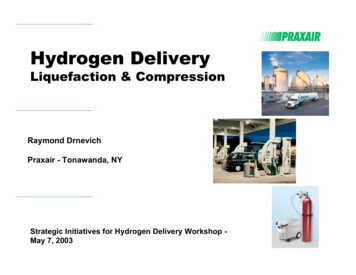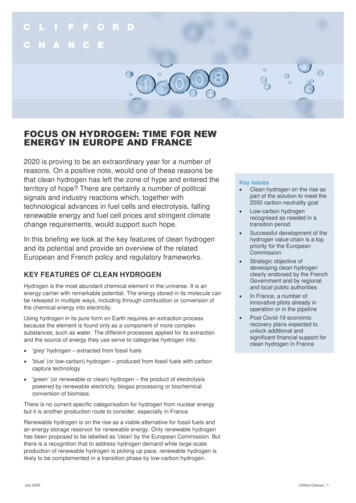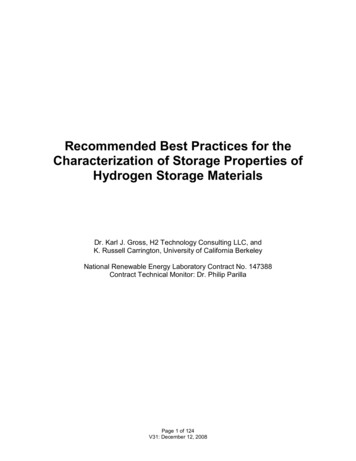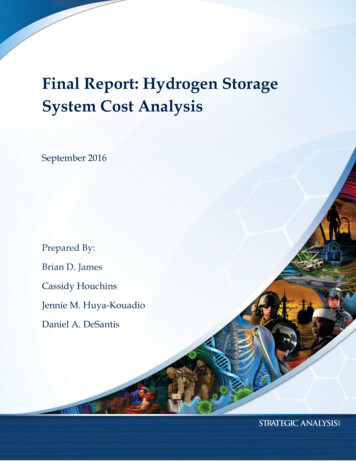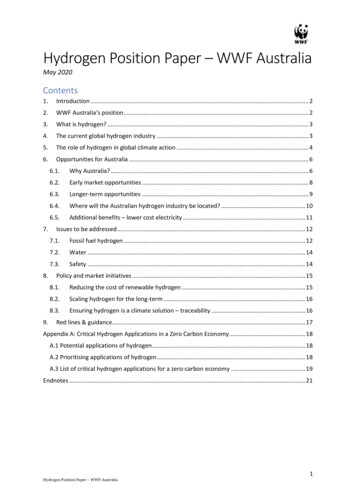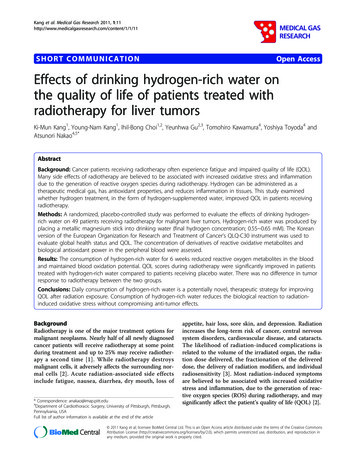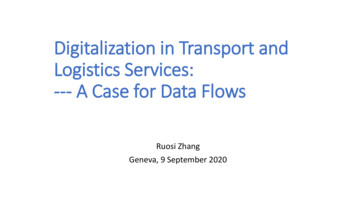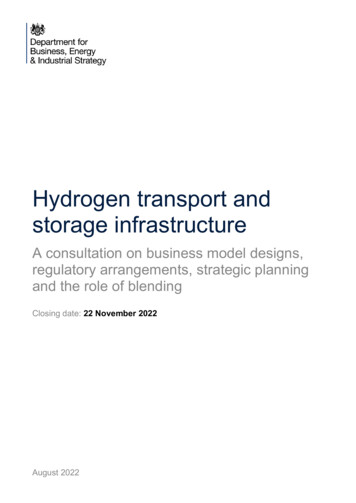
Transcription
Hydrogen transport andstorage infrastructureA consultation on business model designs,regulatory arrangements, strategic planningand the role of blendingClosing date: 22 November 2022August 2022
Crown copyright 2022This publication is licensed under the terms of the Open Government Licence v3.0 except where otherwise stated.To view this licence, visit e/version/3 or write to theInformation Policy Team, The National Archives, Kew, London TW9 4DU, or email:psi@nationalarchives.gsi.gov.uk.Where we have identified any third-party copyright information you will need to obtain permission from thecopyright holders concerned.Any enquiries regarding this publication should be sent to us at: HydrogenTransportandStorage@beis.gov.uk
ContentsGeneral Information 7Why we are consulting 7Consultation details 8How to respond 9Confidentiality and data protection 9Quality assurance 10Chapter 1: Introduction 11Context – The Hydrogen Economy 11This Consultation 12Chapter 2: General Considerations 14The Hydrogen Roadmap 14Our Hydrogen Networks Vision 15Support for Transport and Storage Infrastructure 17Small Scale Infrastructure 17Larger Scale Infrastructure 18Key Principles for Business Model Design 18Chapter 3: Hydrogen Transport Infrastructure 20Background 20Interactions with decision on hydrogen heating in 2026 21Connecting Hydrogen Supply and Demand 21Benefits of Hydrogen Transport Infrastructure 22Facilitation of a Mature Market 22Supporting Decarbonisation of the Electricity System 22Lowering the Need for Hydrogen Production and Storage Capacity 23The Development of Hydrogen Transport Infrastructure 24Types of Hydrogen Transport 24Growth of Hydrogen Transport Infrastructure 25Repurposing Existing Pipelines to Transport Hydrogen 27Case Studies 28Hydrogen Transport Business Model 313
Market Barriers 32Business Model Design Options 34Regulated Returns 34Contractual Payments 35Other Models 36Existing Support for Hydrogen Transport Infrastructure 37Development Phases 38Business Model for a Growth Phase 38Business Model for a Steady State 39Additional Considerations 40Specific Features within Business Model Design Options 40Other Hydrogen Transport Infrastructure 42Other onshore pipelines 42Offshore pipelines 43Vehicular transport 44Chapter 4: Hydrogen Storage Infrastructure 46Background 46Misalignment of Hydrogen Production and Demand 46Benefits of Hydrogen Storage 47Balancing misalignment in hydrogen production and demand 47Supporting decarbonisation of the electricity system 47Reducing hydrogen production capacity requirements 48The Development of Storage Infrastructure 48Types of storage 48Anticipated emergence of storage infrastructure 50Uncertainty in demand for storage capacity 51Challenges to the roll-out of strategic storage infrastructure 51Supporting Investment in Storage Infrastructure 52Market barriers 52Progress to date and remaining challenges 54A business model to address volume and revenue risk 55Business model design – stakeholder needs 56High Level Business Model Design Options for Hydrogen Storage 574
Counterfactual 58Regulated returns 58Contractual payments 59Obligations 60End user subsidies 61Other 61Concluding remarks on business model design options 62Chapter 5: Strategic Planning 64Background 64Hydrogen and the Whole System 64Availability 65Natural gas grid implications 65Power system implications 66CCUS implications 67Transport and Storage Infrastructure Development 67Assessing whole system value 67Approaches to strategic planning 68Case studies 68Strategic Planning Implementation 72Factors to consider in strategic planning 72Institutional features 74Strategic planning interactions with the provision of business model support for transportand/or storage projects 75Early support for “low or no-regrets” and systemically important projects 76Chapter 6: Regulatory Framework 78Market Framework 78Non-Economic Regulation 79Onshore Health and Safety 80Onshore Planning 81Onshore Environment 83Offshore 84Chapter 7: Hydrogen Blending 85Background 855
The Strategic Role of Blending 85Blending to Manage Volume Risk 86Hydrogen Transport and Storage Infrastructure Risk 87Delays to at Scale Adoption by End Users 89Demand Volatility 89Summary and Further Considerations 91Consultation questions 92Next steps 996
Hydrogen transport and storage infrastructure consultationGeneral InformationWhy we are consultingHydrogen can support the decarbonisation of the UK economy, particularly in ‘hard to electrify’UK industrial sectors, and can provide greener, flexible energy across power, transport andpotentially heat. Hydrogen produced in the UK could create thousands of jobs across thecountry, and provide greater domestic energy security, lowering our reliance on energyimports. Analysis by BEIS for Carbon Budget 6 suggests 250-460TWh of hydrogen could beneeded in 2050, making up 20-35 per cent of UK final energy consumption.For these reasons, in the British Energy Security Strategy (BESS) government doubled itsambition to up to 10GW of new low carbon hydrogen production capacity by 2030, subject toaffordability and value for money, with at least half of this coming from electrolytic hydrogenproduction.Hydrogen transport and storage infrastructure will be critical to enable this 10GW ambition, andrelated economic benefits. It will connect producers with consumers, and balancemisalignment in supply and demand. However, lengthy development lead times, high capitalcosts and uncertain financial investment returns in a nascent market mean this infrastructure isunlikely to materialise without a supportive policy framework.For this reason, government committed in the BESS to design new business models forhydrogen transport and storage infrastructure by 2025. This consultation seeks views ondesign options for these business models in order to meet this commitment and enable thehydrogen economy to delivery its substantial potential carbon and economic benefits. Inaddition, it seeks views on the need for a strategic planning function for the rollout of hydrogentransport and storage infrastructure, approaches to wider regulation and implications forblending.7
Hydrogen transport and storage infrastructure consultationConsultation detailsIssued:31 August 2022Respond by:22 November 2022Enquiries to:Email: HydrogenTransportandStorage@beis.gov.ukOrHydrogen Networks and Markets teamDepartment for Business, Energy and Industrial Strategy2nd Floor, Spur1 Victoria StreetLondonSW1H 0FTConsultation reference: Consultation on business model designs, regulatory arrangements,strategic planning and the role of blending.Audiences:This consultation will be of interest to all parties involved in the hydrogen economy: Hydrogen producers Hydrogen consumers Gas transporters Gas shippers Storage operators Investors Consumer champions Trade associations AcademicsTerritorial extent:The territorial extent of the consultation is UK-wide, and responses are invited from all parts ofthe UK. However, certain aspects of the proposals may impact on policy matters that aredevolved in Scotland, Wales, and Northern Ireland. BEIS will work with the devolvedadministrations as we develop the business models in order to ensure that our policies takeaccount of devolved responsibilities. Where proposals are suited to implementation on a UK orGB-wide basis, working with the devolved administrations will facilitate the successfuldeployment of the business models and consistency with devolved policy.8
Hydrogen transport and storage infrastructure consultationHow to respondYour response will be most useful if it is framed in direct response to the questions posed, andwith evidence in support wherever possible. Further comments and wider evidence are alsowelcome. When responding, please state whether you are responding as an individual orrepresenting the views of an organisation.We encourage respondents to make use of the online e-consultation wherever possible whensubmitting responses as this is the Government’s preferred method of receiving responses.However, responses in writing or via email will also be accepted. Should you wish to submityour main response via the e-consultation platform and provide supporting information via hardcopy or email, please be clear that this is part of the same consultation response.Respond online at: gy/hydrogen-transportstorage-consultationEmail to: HydrogenTransportandStorage@beis.gov.ukWrite to:Hydrogen Networks and Markets teamDepartment for Business, Energy and Industrial Strategy2nd Floor, Spur1 Victoria StreetLondonSW1H 0FTConfidentiality and data protectionInformation you provide in response to this consultation, including personal information, maybe disclosed in accordance with UK legislation (the Freedom of Information Act 2000, the DataProtection Act 2018 and the Environmental Information Regulations 2004).If you want the information that you provide to be treated as confidential please tell us, but beaware that we cannot guarantee confidentiality in all circumstances. An automaticconfidentiality disclaimer generated by your IT system will not be regarded by us as aconfidentiality request.We will process your personal data in accordance with all applicable data protection laws. Seeour privacy policy.We will summarise all responses and publish this summary on GOV.UK. The summary willinclude a list of names or organisations that responded, but not people’s personal names,addresses or other contact details.9
Hydrogen transport and storage infrastructure consultationQuality assuranceThis consultation has been carried out in accordance with the government’s consultationprinciples.If you have any complaints about the way this consultation has been conducted, please email:beis.bru@beis.gov.uk.10
Hydrogen transport and storage infrastructure consultationChapter 1: IntroductionContext – The Hydrogen EconomyHydrogen can support the deep decarbonisation of the UK economy, particularly in ‘hard toelectrify’ UK industrial sectors, and can provide greener, flexible energy across power,transport and potentially heat. Hydrogen produced in the UK will create new jobs across thecountry, and secure greater domestic energy security, lowering our reliance on energy imports.Analysis by BEIS for CB6 suggests 250-460TWh of hydrogen could be needed in 2050,making up 20-35 per cent of UK final energy consumption. 1In 2021, the UK Government published the Net Zero Strategy, which sets out policies andproposals for decarbonising all sectors of the UK economy to meet our net zero target by2050. 2 This supports the preceding publications of the Hydrogen Strategy and the PrimeMinister’s Ten Point Plan, along with other notable publications that set out the development ofthe UK hydrogen economy as a UK Government priority. Building on the Ten Point Plan andHydrogen Strategy, the British Energy Security Strategy (BESS) doubled our 5GW low carbonhydrogen production capacity ambition to deliver up to 10GW by 2030, subject to affordabilityand value for money, with at least half of this coming from electrolytic hydrogen. 3 Thesestrategies combine near term pace and action with clear, long-term direction to unlock theinnovation and investment critical to meeting our energy security and net zero ambitions.Hydrogen transport and storage infrastructure will be critical enablers for the necessary growthin the hydrogen economy required to meet our 10GW ambition, which could support over12,000 jobs in hydrogen production, distribution, and storage by 2030. 4 Alongside connectingproducers and consumers, a well-developed hydrogen transport and storage network could beespecially valuable for system flexibility. Excess renewable electricity can be used to producehydrogen, which then can be stored over time. Analysis by AFRY estimates that long durationenergy storage, supplied predominantly by hydrogen, 5 could provide between 13-24bnsavings to the electricity system between 2030 and 2050 – by reducing network constraintsand seasonal imbalances emerging from an increasingly weather-driven system. 6Nonetheless, infrastructure projects may have lengthy development lead times, high capitalImpact Assessment for the Sixth Carbon Budget /pdfs/ukia 20210018 en.pdf2 Net Zero Strategy: Build Back Greener (2021): o-strategy3 British Energy Security Strategy (2022): trategy4 Internal BEIS analysis based on the Energy Innovation Needs Assessment (EINA) methodology with updateddomestic and global scenarios; figures consider jobs linked to hydrogen production, distribution, and storage.EINA methodology provided by Vivid Economics (2019): nnovation-needs-assessments5 Multiple assets are required to enable hydrogen to power. These include hydrogen production (e.g., electrolysis),hydrogen storage (e.g., salt caverns) and H2 to power generators (e.g., hydrogen CCGTs)6 The savings are predominantly driven by reduced fuel costs for generators. The analysis assumes hydrogenstorage infrastructure is already built and so does not include the costs associated with this, nor the costs of derisking necessary technologies. Please refer to the original analysis for details on the 111
Hydrogen transport and storage infrastructure consultationcosts, and uncertain financial investment returns in a nascent market, meaning transport andstorage infrastructure is unlikely to materialise in the absence of supportive policy andcommercial frameworks. For this reason, we also committed in the BESS to design newbusiness models for hydrogen transport and hydrogen storage infrastructure by 2025. This is aclear commitment by government to provide a supportive commercial framework to unlock thesignificant infrastructure investment that is likely to be required to deliver the future hydrogeneconomy.This ConsultationThis consultation is the first step in meeting our BESS commitment to design new businessmodels for hydrogen transport and storage infrastructure by 2025. We are seeking stakeholderviews on high level business model design options for hydrogen transport and hydrogenstorage, as well as whether the options we have identified are appropriate and proportionatefor stakeholders, which options stakeholders prefer, and why. We are mindful that anevolutionary approach to the business model designs, and the wider regulatory and marketframeworks they will sit within, may be required. This consultation therefore also seeks viewson system planning, the regulatory framework, and the potential role of blending to support thiswider journey.Your feedback will enable us to develop informed policy and legislation.Chapter 2 sets out the general considerations that inform this consultation and seeks views onour overall approach and design principles.Chapter 3 sets out potential high-level business model design options for hydrogen transportinfrastructure. This chapter seeks views on which business model design is most appropriate.There is an initial focus on onshore pipelines transporting hydrogen as a gas but views aresought on other hydrogen transport infrastructure and methods of transport.Chapter 4 considers the role of hydrogen storage, both within the hydrogen economy andmore widely, by providing flexibility across the whole energy system. It considers the types ofstorage infrastructure that might be deployed, how it is expected to emerge and the marketbarriers that might deter investment and timely deployment. It concludes by considering howthose market barriers might be addressed through the implementation of a business model,with a number of possible options presented for comment.Chapter 5 considers the need for strategic planning to support the development of hydrogentransport and storage infrastructure, as the UK moves to a decarbonised energy system. Itexplores different approaches to strategic planning, what factors may need to be considered,interactions with the provision of business model support and whether early support for “low orno-regrets” and systemically important projects is required.Chapter 6 explores the wider supporting regulatory landscape for hydrogen transport andstorage infrastructure (as well as covering production and end use). This chapter asksquestions to support BEIS and other bodies to help ensure that both a conducive market12
Hydrogen transport and storage infrastructure consultationframework and industry commercial arrangements, as well as broader non-economicregulatory measures are in place, workable, and optimal for project development.Chapter 7 seeks to better understand the hydrogen market-building potential of allowinghydrogen blending into the existing gas grid, and how this might affect the economic andstrategic case for blending. This includes assessing the scale of any gap between productionvolumes being ready to come online and large-scale hydrogen transport and storageinfrastructure being developed, and blending’s potential to bridge this gap. The chapter alsoexplores the potential role of blending to act as a reserve offtaker to help bring forwardinvestment and support delivery of our hydrogen ambitions.The scope of the consultation is UK-wide, and responses are invited from all parts of the UK.However, certain aspects of the proposals may impact on policy matters that are devolved inScotland, Wales, and Northern Ireland. BEIS will work with the devolved administrations as wedevelop the business models in order to ensure that our policies take account of devolvedresponsibilities. Where proposals are suited to implementation on a UK or GB-wide basis,working with the devolved administrations will facilitate the successful deployment of thebusiness models and consistency with devolved policy.The scope of this consultation is also not limited to the transport and storage of low carbonhydrogen. BEIS intends for new, low carbon hydrogen to provide cleaner energy to meet ourdecarbonisation ambitions as set out in previous publications. Nonetheless, for security ofsupply reasons, transport and storage may need to be available to all forms of hydrogen in theevent of unintended risks to low carbon hydrogen supplies, and the subsequent need to ensurehydrogen can be transported and stored effectively to avoid risks of disruption of hydrogensupply to consumers.13
Hydrogen transport and storage infrastructure consultationChapter 2: General ConsiderationsThe Hydrogen RoadmapThe Hydrogen Strategy included a roadmap which set out our vision for the expected growth ofthe hydrogen economy in the 2020s and beyond, which was largely based on incrementalgrowth and an increasingly more integrated transport and storage network for low carbonhydrogen. The size and nature of the hydrogen economy and supporting network in 2050 willdepend on several factors and policy decisions. This includes the roles of hydrogen across itsdifferent potential end uses in industry, power, transport and potentially heat. As summarisedin the Hydrogen Economy 2020s Roadmap (Figure 1), we expect the hydrogen economy toreach regional and/or national scale transmission networks supported by both small and largescale storage from the mid-2030s onwards. 7Figure 1: Hydrogen Economy 2020s Roadmap (Hydrogen Strategy)Hydrogen Strategy (2021): ogen-strategy. Note that theBritish Energy Security Strategy has since updated the hydrogen production capacity ambition for 2025 to2GW/2030 to 10GW, and the offshore wind capacity ambition up to 50GW by 2030714
Hydrogen transport and storage infrastructure consultationOur Hydrogen Networks VisionOur vision for hydrogen transport and storage infrastructure builds on our Hydrogen Strategyroadmap. We aim to reach a large, liquid and competitive hydrogen market enabled by anintegrated and resilient network with multiple entry and exit points, connected to severalhydrogen storage facilities at various scales. This may begin to materialise from the mid-2030sand beyond. 8 In time, we expect the market to be able to operate free of subsidy, althoughlikely not free of regulation (much like the existing gas networks today).We consider that business models for both hydrogen transport and storage are required toremove market barriers and stimulate private investment in the necessary supportinginfrastructure, to deliver this vision of how hydrogen can play its full role in decarbonising theUK economy. The types of transport and storage infrastructure and examples beingconsidered within this consultation are summarised in Table 1.Table 1: Types of hydrogen transport and storage infrastructureInfrastructure typeExamplesTransmission pressure hydrogen pipelines (new orrepurposed)TransportDistribution pressure hydrogen pipelines (new orrepurposed)Non-pipeline transportation (e.g. road & rail vehicles, ormarine vessels)Depleted gas or oil fieldsSalt or rock cavernsStorageAquifersContainers for compressed or liquified hydrogenHydrogen carriersMetal hydridesGiven the nascent state of the current UK low carbon hydrogen economy, we anticipate thatthe journey to our envisaged end state will transition through several phases. Practical projectdelivery will depend on early decisions to accommodate investment timetables. 8In the mid-2020s, we intend for dedicated small-scale pipeline transport for individualproducers to pipe hydrogen to users co-located on the same or close industrial sites.We also envisage expanded trucking and small-scale storage, capable of supportinglarge-scale CCUS-enabled production in at least one location, as well as electrolyticproduction. This aligns with our expectation that up to 2GW of low carbon hydrogenHydrogen Strategy (2021): ogen-strategy15
Hydrogen transport and storage infrastructure consultationproduction capacity will be in operation or construction by 2025. 9 This will be used forindustrial and early transport applications, as well as a village-sized trial of 100%hydrogen heating. In the late 2020s, we envisage larger within-cluster networks supported by both smalland large-scale hydrogen storage, serving a greater number and wider variety of enduses across industry, power generation, transport and potentially for a hydrogen heatedtown. 10 We may also see some early off-cluster pipelines and storage developmentcentred on electrolytic production, for example, to increase flexibility and efficiency inareas where renewable electricity generation is constrained by the capacity of theelectricity grid. From the mid-2030s onwards, we envisage regional and/or national scale networks tobe developing, supported by systemic large-scale storage infrastructure and integratedwith CCUS, gas and electricity networks. This could enable a full range of hydrogenproduction technologies to service a full range of end users (potentially including heat inbuildings) via a large, liquid and resilient market, with the potential to further transition tobeing free of subsidy (if not regulation).The exact scale of this end state (and the journey leading there) will be significantly affected bya number of factors, for example: Geographical location and interactions with producers and end users of hydrogen will beextremely important in determining the need for, and potential value of, both hydrogentransport and hydrogen storage infrastructure. Strategic planning, which thisconsultation also considers, may be required to account for the locational and systemicdesign of hydrogen networks, to enable an optimal transition to a well-functioninghydrogen market. Wider market developments, including the role of imports and exports, as well as futuretechnological developments, such as hydrogen carriers like ammonia or liquid organichydrogen carriers (LOHCs). Wider policy decisions – for example those covering production and end use markets,including the strategic decisions in 2026 on the role of hydrogen in heatdecarbonisation, and the decision on blending hydrogen into the gas distributionnetworks, which is aimed for 2023. However, we do not anticipate that the overall needfor a large, integrated, and resilient hydrogen transport and storage network will becritically contingent on decisions and developments around hydrogen use in heating,especially given hydrogen’s wider value for flexibility and as a storage solution. Demandfor low carbon hydrogen in industry, power and transport is estimated to reach between125-285TWh in 2050. 119 Hydrogen Investor Roadmap: Leading The Way to Net Zero ero10 In 2026, the Government will take strategic decisions on the role of hydrogen in heating, including whether ornot to proceed with delivering a hydrogen heated town11 Demand estimates are from the Hydrogen Analytical Annex: gen-strategy. Upper and lower estimates of demand in 2
By providing low-carbon hydrogen for power generation, hydrogen storage has the potential to displace and replace higher-carbon alternatives and therefore contribute to the delivery of the government's commitment for a fully decarbonised power sector by 2035 (subject to security of supply).
